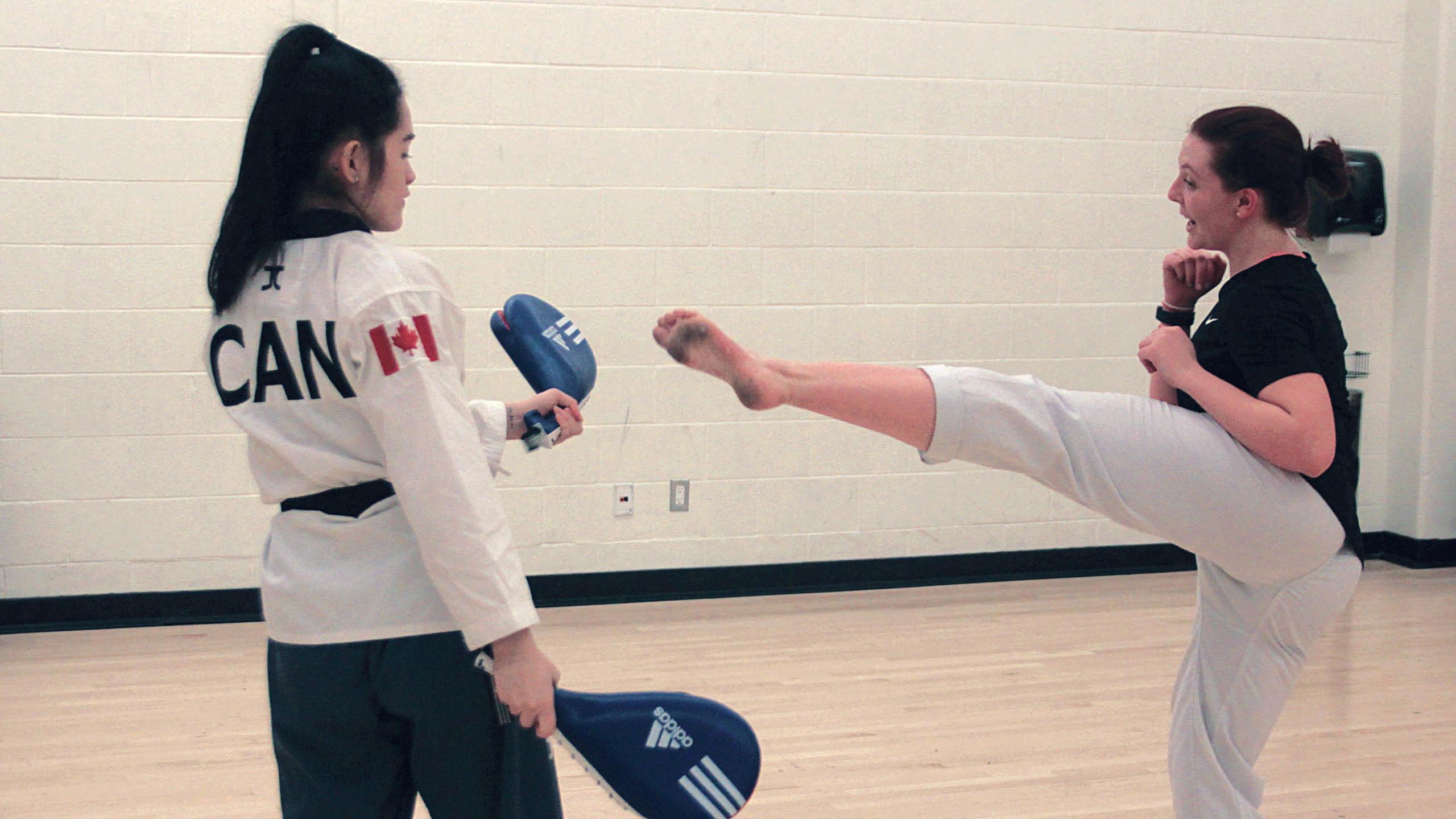By Andrea Josic
At 7 p.m. on a Monday, it’s not unusual for Ryerson’s campus to feel empty, but at the Mattamy Athletic Centre, there are a handful of students scattered around the gym.
Though it may seem quiet after hours, in the far right corner of the gym, three members of Ryerson’s taekwondo team are completing intense circuit training. They’re here every Monday and Thursday night, and occasionally on Saturday mornings, building endurance and learning about the art of the sport.
Taekwondo can be traced back to Korea in the 1940s and 1950s. Instead of focusing on hand-to-hand combat (like karate) and close-range combination fighting (kung fu), taekwondo focuses on the art of the foot. It was brought to Canada in 1964 by Grand Master Chong Lee and Taekwondo Canada, the official national sport federation for taekwondo, founded in 1981. Although taekwondo has been in Canada for decades, Ryerson has only had a team of its own for 11 years.
Alexander Frias was doing his undergrad in aerospace engineering when he felt something missing at Ryerson. At the time, there were a few martial arts programs, including karate and kung fu. So in the fall of 2007, Frias founded the taekwondo team, creating a place for students to hone their skills.
Starting the club on his own was difficult. The master from the school Frias trained at donated kicking pads to get the new team started. It was up to Frias to get funding for the rest of it. He applied for sports grants, and eventually secured $1,000. Ryerson students pay $100 per semester to participate, which helps sustain the club.
Frias based the club on World Taekwondo’s standards for taekwondo, the same style used in the Olympics. For three years, Frias ran the team on his own, teaching beginner and advanced classes every semester. It wasn’t until his first round teaching black belt students that the team gained its first volunteer instructor.
“One of the black belt graduates, who was also a very good friend, had the gift of teaching,” said Frias. “He helped me put together the first members of the competitive team.”
In 2007, Ryerson collaborated with four other Canadian university clubs to create the first Ontario Universities Taekwondo Competitive League (OUTCL). At the time, Ryerson had eight taekwondo athletes training competitively. A few years later, Ryerson didn’t have enough members to continue competing as a team and had to leave the league.
Ashley Leong, a second-year graphic communications management student, joined the taekwondo team in her first year because she wanted to get access to a gym for training. She already had a black belt and was on the Canadian national team.
After Leong had been practicing with the Ryerson team for a year, Frias approached her and asked her to become an instructor. Leong now instructs the Monday night classes, consisting of circuit training to build stamina and endurance for patterns, which are a sequence of non-combative martial arts techniques.
A national champion in patterns, Leong prefers instructing patterns because they build more muscle, allowing athletes to be able to hold their kicks for a long period of time. Sparring athletes need to develop lean muscle so they can kick faster.
While team numbers and skill levels fluctuate, there are currently 10 members on the team, most of whom are beginners, Leong said.
“This semester there’s less students,” said Leong. “It’s more recreational so a lot of people are just doing it for exercise or to learn the basics of taekwondo.”
Students have the choice to participate in local competitions divided into age, weight and belt levels. At the end of each semester, students are able to do belt testing and advance to the next belt level.
The classes are open to non-Ryerson students as well, so Frank Lec was happy to sign up. After spending decades practicing taekwondo around the world, Lec moved back to Toronto in 2012. He thoroughly researched local clubs when he came across Ryerson’s. The price ($200 per semester for non-students) was affordable for him, and because Lec was the highest-ranking member at the time, Frias asked him to take over coordination and instruction duties.
Even after five years, Lec said it’s difficult to plan for the club’s future. Great athletes leave due to graduation, and schedules vary each semester, so the turnover rate is generally high.
The team mostly consists of beginners, so Frias focuses on teaching basic skills and rules of taekwondo.
He strives to teach members about the integrity of taekwondo, which he believes is more important than competition or fitness goals. Each participant is different, so Frias can’t foresee where the team will go in the future, but he knows his way of teaching won’t change.
“The goal remains the same regardless of time—keeping the spirit of taekwondo alive and true.”










Leave a Reply